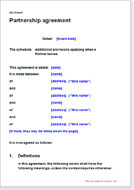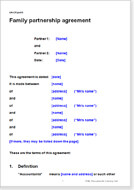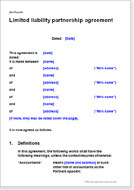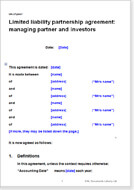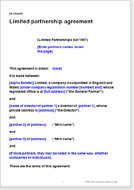Partnership agreements
These agreements allow you to set out in detail how your partnership operates: what each partner may and may not do for the business, and how liability is shared. We include templates to form all three types of structure: LPs, LLPs and standard partnerships under the 1890 Act.
Partnership agreement
This is a modern, comprehensive partnership agreement suitable for a business in any industry and with any number of partners.
It covers a large number of practical, commercial and administrative points that will help you manage your business and inter-partner relationships. This document should give you a high level of protection in today’s environment.
Despite the completeness and thoroughness of this document, editing is easy. It is written in plain English, without legal jargon or complicated paragraph referencing so that you can simply and easily delete what you don't need.
Family partnership agreement
This partnership agreement has been drawn for people working in business together who simply do not need the full version we also offer - most likely because there is already a high level of trust and co-operation between the business partners.
However, we must make clear that this is not a basic or cut down version. This document has been professionally drawn to protect your interests and to provide a useful commercial framework for your work together.
Many families or groups of friends enter into business with each other without a formal agreement because they feel that there is no need to formalise the relationship when the partners trust each other. That is fine - the reason to use a partnership agreement with family and friends does not have to be for protection, but should be to contract out of the brutal default provisions of the Partnership Act 1890.
This agreement is ideal for groups of friends working together or for a family business, and for example, could be put in place when:
- two or more friends start a new business together
- a new person takes a share in an existing business operated by one person
- existing family partners want to formalise their partnership agreement
- existing partners want to change the balance of control and ownership of the business
Limited liability partnership agreement
Protect your privacy with this professionally drawn and comprehensive limited liability partnership agreement.
The Limited Liability Partnership Act 2000 provides the structural framework for this agreement. Within that framework, you are free to make whatever arrangements you like, subject to normal contract law. This gives you great freedom, which is reflected in the many suggestions given in this agreement.
In this version, most or all partners are involved in running the business. It is drawn to cover a wide range of business sectors.
The document provides for statutory requirements as well as all usual inter-partner issues.
It also provides additional terms covering how a modern day business operates. Use it not only to protect legal rights but also to set out how you want your LLP to work.
The agreement covers not only partner rights, management obligations and procedures, but for example: protection of established and new intellectual property and derived products.
Limited liability partnership agreement: managing partner and investors
This is a version of our standard LLP agreement, drawn for circumstances where one or more managing partners operate a business on behalf of others who do not play an active role in the day to day management.
It is most likely to be used to set out arrangements for an investment business, such as a venture capital fund or a vehicle for a family-owned company, where you want the privacy provided by an LLP.
It sets out the arrangements between the partners in much the same way as a shareholders’ agreement for a company. This document is suitable for a business in any industry.
Example uses of this document
- for a business where there are regular changes in ownership of partnership 'shares'
- where you have a greater requirement for privacy than is possible using a limited company
- where you want to limit the liability of investor partners by transferring from a conventional partnership
- where the partners are scattered, maybe working in different cities
where the nature of the business is high risk, and there is a requirement to keep safe the personal assets of the partners
Limited partnership agreement
This is a professionally drawn agreement to set up a partnership under the Limited Partnerships Act 1907.
This form of agreement is used most commonly for high risk ventures in property, finance, mining or research, where one or more partners is a limited company.
A limited partnership enables a single partner to carry the liability. That partner may be a limited company with few or no assets, so preserving the assets of other partners. Often, all partners are companies.
The registration requirement is very light. There is no requirement for submission of returns. Secrecy can be maintained.
The business of the partnership is assumed to be a single project or goal, short or long term.

If the document isn’t right for your circumstances for any reason, just tell us and we’ll refund you in full immediately.

We avoid legal terminology unless necessary. Plain English makes our documents easy to understand, easy to edit and more likely to be accepted.

You don’t need legal knowledge to use our documents. We explain what to edit and how in the guidance notes included at the end of the document.

Email us with questions about editing your document. Use our Lawyer Assist service if you’d like our legal team to check your document will do as you intend.

Our documents comply with the latest relevant law. Our lawyers regularly review how new law affects each document in our library.
What is a partnership agreement?
A partnership agreement (also known as business partnership agreement and partnership contract) is a legal document used when two or more people enter into formal arrangement to manage and operate a partnership business with the aim make profits.
The partnership agreement sets out the key details that relate to operating the business partnership such as, amongst others, identifying the partners, initial capital contribution by partners, sharing profits and losses, each partner's share, decision making, further capital contribution, and dissolution of the partnership.
The purpose of the partnership agreement is to provide a business structure that regulates all aspects of operation of the business partnership and to provide a framework that regulates the relationship that exist between each individual partner.
What matters are the arrangements, not the business sector
A partnership agreement is all about the structure and management of a business. It does not matter what industry the partners work in. They could be professionals, like accountants or architects, they could be tradespeople like retailers or home extension experts, they could be family members working together such as on a farm, or they could operate a more unusual business in property or finance or international trade.
Furthermore, your business as partners could be a single specific project, such as a technology development project, and does not necessarily have to be commercial in nature.
Partnerships are quite distinct from companies in many areas, so the issues you need to cover in your agreement can be quite different to those that owners of a company might consider.
Avoiding the 1890 Partnership Act
The law relating to partnerships is over 100 years old. It provides default positions if you have no partnership agreement or if your business partnership agreement fails to cover an issue in contention.
Common issues with informal business partnerships
The problem is that, for the modern business, those default positions are unlikely to be what you want. In particular, you are likely neither to want equal ownership and liability with other partners, nor the default method for ending the partnership.
Unless your agreement states otherwise, all the partners have equal rights to take on contracts and equal responsibility to fulfil them. Profits and losses are also shared equally.
Commonly in partnerships, disagreements occur over contributions to the business and how profit and assets should be divided. In the real world, partners do not contribute equally.
The solution is to use a written partnership agreement
You should use a comprehensive written agreement to override these default positions. Your business partnership agreement should set out how skills, initial funding, different working hours and “assets” such as customer contact lists are valued, because different people place very different values on them. If you work for six days a week but your partner only works for two, you will want to make sure you are rewarded for your additional effort.
Liability is also joint and equal. Without a partnership agreement stating otherwise, a partner could make a contract in the course of partnership business that carries high risk. If that contract goes wrong, he or she, and all the other partners are liable for partnership debts equally. A partner in a business that isn’t regulated by a partnership agreement can find himself or herself in a position of personal bankruptcy as a result of a bad decision made by someone else, and about which the partner wasn’t made aware.
The other default position of the 1890 Act to avoid relates the ending of the partnership – the dissolution. The Act provides only one way to handle a partnership split or break. That is to put everything under the hammer at auction, leaving the partners to buy or not, as they choose. In our regulated society and business environment, that outdated provision can cause huge problems. The only way to avoid it is to have a modern partnership agreement which provides a proper exit route.
However, there is far more to a Net Lawman partnership agreement than just overriding these defaults. Each of these partnership agreement template provides a large framework for a modern partnership with many options, and extensive notes that guide you carefully through, paragraph by paragraph.
Why a short agreement is unlikely to be suitable for you
Other partnership agreements on the Internet, particularly ‘short’ versions, might cover the basics to form a partnership, but they aren’t likely to protect your interest in your new business sufficiently. Far more issues are considered in our documents than in any other partnership agreement template we have seen.
For example, the Net Lawman partnership agreement templates provide a set of easy to edit paragraphs covering intellectual property protection in depth. Most businesses have valuable IP, whether know-how or designs, but few partnership agreement templates address intellectual property, whether recognising who brings it into partnership, or who has the right to use it during and once the partnership ends. We help you to identify and protect ownership of valuable intellectual property and other assets that belong to just one partner.
What should a partnership agreement cover?
The short answer is that a business partnership agreement should cover everything of importance. Otherwise, you will be stuck with the default positions under the Partnership Act.
The point of having a partnership agreement is that you will have a detailed document that governs every aspect of management and operation of the business partnership. So for a partnership agreement to do its job, it must be a comprehensive document.
Some important provision a modern business partnership need in their business partnership agreement include:
- how new partners are taken in
- how assets and capital brought into the business partnership (specifically property and cash) are owned
- how profits and losses are shared
- how a partner can be removed from the business partnership (for example, if they are involved in a malicious or criminal act or committ a material breach of the partnership agreement or of their fiduciary duties) and the process for doing so (for example, through a written notice)
- how decisions concerning the business partnership will be made (a proper procedure for authority and voting
- how further captial contributions will be made
- how dissolution of the partnership will occur
- procedures when a partner dies
Should you use a partner agreement for your family business?
The importance of having a written partnership agreement is not diminished if a husband or wife or family members are running a business together.
While, a family business partnership agreement does not have to be as formal as a general partnership agreement where the all the partners not personally known to you. You still need to have a partnership agreement.
Informal partnerships can present come serious concerns for family businesses. For example, in the absence of a partnership agreement, the default rule regarding ownership will apply that assume that the business is owned equally by all the partners. This may not be the arrangement you would prefer to have. While equal partnership in a family business may seen natural, it can get very tough to resolve a dispute if all the partners are adamant on their position.
Who should use these agreements
The purpose of a partnership agreement is to set out the arrangements between the parties about how they will work, in much the same way as a shareholders’ agreement does for a company. So these templates have a wide range of uses.
- They are ideal for partnerships with between two and ten partners.
- Ownership of partnership assets and share of income and expenses does not have to be in equal proportions. Your sharing ratio could be 50:50, but it could also be 60:40, 70:30 or any other.
- These agreements can be used if one or more of the partners is 'sleeping' or 'silent', i.e. contributes money, experience or assets but does not take part in the day to day running of the business.
- Whilst partners are likely to be human individuals, these agreements can be used where one or more is a company or a not-for-profit organisation.
What these partnership agreement templates contain
You need a partnership agreement to record all the points agreed about what exactly is the partnership business; how you will manage it; who may take out what money, and much more.
These are professionally drawn, comprehensive documents designed to protect and help you. As well as giving you a legal structure, they contain extensive commercial and practical provisions that will help you manage your business and inter-partner relationships.
Despite the completeness and thoroughness of these documents, editing is easy. They are written in plain English, without legal jargon or complicated paragraph referencing so that you can simply and easily delete what you don't need.
Just a few of the provisions covered include:
- loans to the partnership
- banking arrangements
- records and accounts
- meetings and voting
- holidays and absence
- cars
- insurance
- good faith
- partnership policies
- restrictions on partners
- intellectual property
- confidentiality
- no competition
- expulsion
- termination of the partnership
- after termination
- indemnity for the partnership
- publicity and announcements
Limited liability partnerships
Two of these partnership agreements are LLP agreements. One covers a situation where all the partners work in the business and the other deals with working partners and “silent” partners. The latter are usually financiers or investors.
These partnership agreements provide for the differences in the legal structure of LLPs, and also set down a management regimen which is slightly stricter than that for a general partnership. You could say it was a step closer to the management of a limited company.
These too, are comprehensive partnership agreement templates with many options. For example, if your business is in science, technology or creative work, you will appreciate the very full provisions for management and protection of established and new intellectual property rights, new inventions, and derived products.
The limited partnership agreements also cover:
- basic provisions and legal requirements for an LLP
- partnership shares and variations
- partnership property, capital and shares
- loans to the partnership
- duties of designated partners
- actions for which partnership consent is required
- management and partner control issues
- intellectual property protection options
- confidentiality
- restrictions on partners
- retirement, death or expulsion
- termination of the partnership
- information required by the Registrar
Limited partnerships
This document concerns a partnership “animal” which has been quietly active for over 100 years, often used for tax reasons or for limiting liability.
The Limited Partnerships Act 1907 enables you to set up a trading vehicle where only one partner can be liable if things go wrong. Unlike the modern LLP, no registration is required and no special rules apply. So far as it is regulated, the Partnership Act 1890 applies, as it does to any ordinary partnership.
All documentation is in plain English as promised + easy to amend as well as being legally accurate and useful to us. This service has probably saved us £1000 in legal fees.
I would definitely recommend to others for the above reasons
All rights reserved

